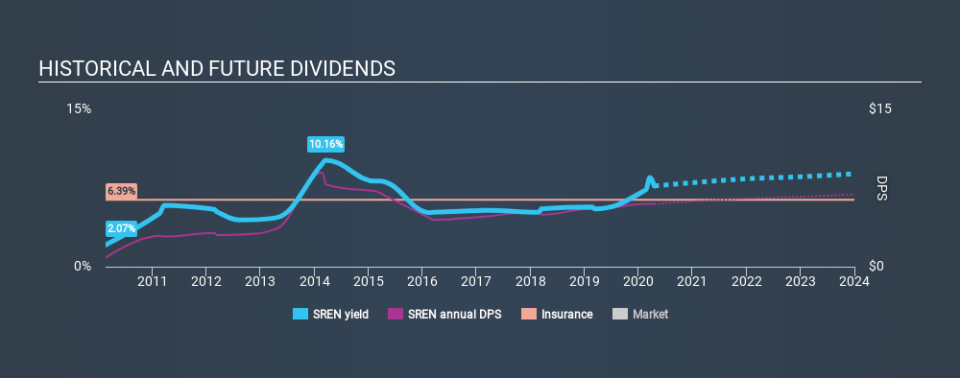Why You Should Leave Swiss Re AG's (VTX:SREN) Upcoming Dividend On The Shelf

Some investors rely on dividends for growing their wealth, and if you're one of those dividend sleuths, you might be intrigued to know that Swiss Re AG (VTX:SREN) is about to go ex-dividend in just 3 days. Ex-dividend means that investors that purchase the stock on or after the 21st of April will not receive this dividend, which will be paid on the 23rd of April.
Swiss Re's next dividend payment will be CHF5.90 per share, on the back of last year when the company paid a total of CHF5.99 to shareholders. Calculating the last year's worth of payments shows that Swiss Re has a trailing yield of 7.7% on the current share price of CHF75.46. If you buy this business for its dividend, you should have an idea of whether Swiss Re's dividend is reliable and sustainable. As a result, readers should always check whether Swiss Re has been able to grow its dividends, or if the dividend might be cut.
See our latest analysis for Swiss Re
Dividends are usually paid out of company profits, so if a company pays out more than it earned then its dividend is usually at greater risk of being cut. Swiss Re paid out a disturbingly high 248% of its profit as dividends last year, which makes us concerned there's something we don't fully understand in the business.
When a company pays out a dividend that is not well covered by profits, the dividend is generally seen as more vulnerable to being cut.
Click here to see the company's payout ratio, plus analyst estimates of its future dividends.
Have Earnings And Dividends Been Growing?
Companies with falling earnings are riskier for dividend shareholders. If earnings decline and the company is forced to cut its dividend, investors could watch the value of their investment go up in smoke. With that in mind, we're discomforted by Swiss Re's 25% per annum decline in earnings in the past five years. When earnings per share fall, the maximum amount of dividends that can be paid also falls.
Another key way to measure a company's dividend prospects is by measuring its historical rate of dividend growth. Since the start of our data, ten years ago, Swiss Re has lifted its dividend by approximately 21% a year on average. The only way to pay higher dividends when earnings are shrinking is either to pay out a larger percentage of profits, spend cash from the balance sheet, or borrow the money. Swiss Re is already paying out a high percentage of its income, so without earnings growth, we're doubtful of whether this dividend will grow much in the future.
Final Takeaway
From a dividend perspective, should investors buy or avoid Swiss Re? Not only are earnings per share shrinking, but Swiss Re is paying out a disconcertingly high percentage of its profit as dividends. It's not that we hate the business, but we feel that these characeristics are not desirable for investors seeking a reliable dividend stock to own for the long term. Swiss Re doesn't appear to have a lot going for it, and we're not inclined to take a risk on owning it for the dividend.
With that in mind though, if the poor dividend characteristics of Swiss Re don't faze you, it's worth being mindful of the risks involved with this business. For example, we've found 2 warning signs for Swiss Re that we recommend you consider before investing in the business.
We wouldn't recommend just buying the first dividend stock you see, though. Here's a list of interesting dividend stocks with a greater than 2% yield and an upcoming dividend.
If you spot an error that warrants correction, please contact the editor at editorial-team@simplywallst.com. This article by Simply Wall St is general in nature. It does not constitute a recommendation to buy or sell any stock, and does not take account of your objectives, or your financial situation. Simply Wall St has no position in the stocks mentioned.
We aim to bring you long-term focused research analysis driven by fundamental data. Note that our analysis may not factor in the latest price-sensitive company announcements or qualitative material. Thank you for reading.

 Yahoo Finance
Yahoo Finance 
